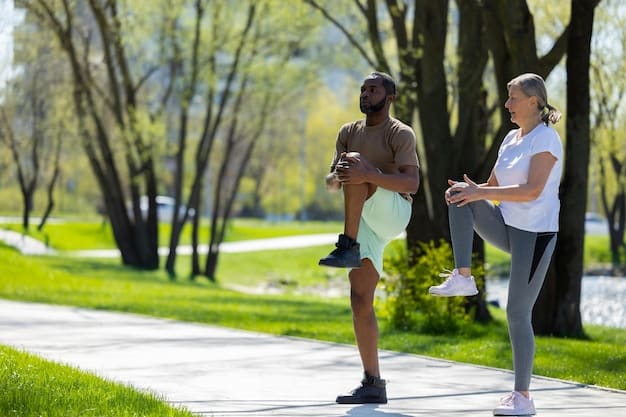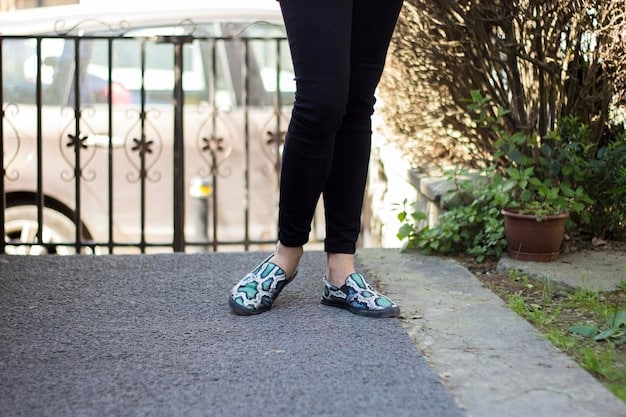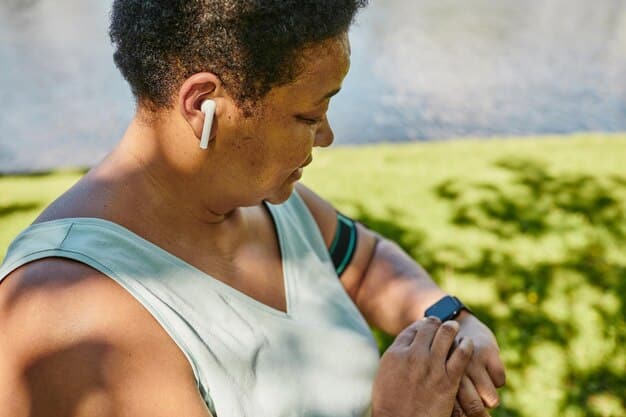Walking for Weight Loss: A Beginner’s Guide

Walking for weight loss is an accessible and effective way to burn calories, improve cardiovascular health, and boost your mood, making it an ideal exercise for beginners looking to reach their fitness goals.
Embarking on a weight loss journey can seem daunting, but it doesn’t have to be. Walking for weight loss: A beginner’s guide to reaching your goals provides a simple, yet effective strategy that anyone can incorporate into their daily routine, regardless of fitness level. Let’s explore how you can start walking your way to a healthier you.
Walking for Weight Loss: Why Choose Walking?
Walking is often underestimated as a form of exercise, but it’s one of the most accessible and sustainable ways to lose weight and improve overall health. Unlike high-impact activities, walking is gentle on your joints, making it suitable for people of all ages and fitness levels.
But why should you consider walking for weight loss? Let’s delve into the benefits and see why it’s a perfect choice for beginners.
Low Impact and Accessible
One of the primary reasons walking is a fantastic option for beginners is its low-impact nature. This means it places minimal stress on your joints, reducing the risk of injury compared to running or other high-intensity workouts.
Additionally, walking is accessible to almost everyone. You don’t need special equipment or a gym membership. All you need is a comfortable pair of shoes and a safe place to walk.
Burns Calories
Walking is an effective way to burn calories, which is crucial for weight loss. The number of calories you burn depends on various factors, including your weight, walking speed, and the duration of your walk. Over time, consistently burning more calories than you consume leads to weight loss.
Moreover, walking can help increase your metabolism, allowing you to burn more calories even when you’re not actively exercising.
- 🚶♀️ Start slowly and gradually increase your pace and distance.
- ⏱️ Aim for at least 30 minutes of brisk walking most days of the week.
- ⛰️ Incorporate hills or inclines to burn more calories.
In summary, walking stands out as an ideal exercise for weight loss particularly if you’re new to fitness. Its accessibility, low-impact nature and effectiveness in burning calories combine to create a sustainable and enjoyable path towards improved health and weight management.

Setting Realistic Goals for Walking and Weight Loss
Setting clear, achievable goals is crucial for any weight loss plan, including walking. Without concrete goals, it’s easy to lose motivation or feel overwhelmed. Let’s explore how to set realistic goals that will keep you on track and motivated.
First things first, define what you want to achieve. Do you want to lose a specific amount of weight, improve your stamina, or simply feel healthier. Your goals should be SMART – Specific, Measurable, Achievable, Relevant, and Time-bound.
SMART Goals Explained
SMART goals are a framework that helps you create effective and attainable goals. Here’s how it works:
- 🎯 Specific: Instead of saying “I want to lose weight,” set a specific target like “I want to lose 1-2 pounds per week.”
- 📏 Measurable: Track your progress by weighing yourself weekly and monitoring your walking distance and time.
- ✅ Achievable: Ensure your goals are realistic for your current fitness level. Don’t aim to walk 5 miles a day if you’re just starting out.
- 🌱 Relevant: Make sure your goals align with your overall health and lifestyle aspirations.
- 📅 Time-bound: Set a deadline for achieving your goals, such as “I want to lose 10 pounds in 10 weeks.”
Examples of Walking Goals
Here are a few examples of SMART walking goals that you can adapt to your own needs:
- Beginner: Walk for 30 minutes, three times a week, at a moderate pace.
- Intermediate: Increase your walking frequency to five times a week, and include one longer walk of 45-60 minutes.
- Advanced: Walk daily for at least 45 minutes, incorporating hills or intervals to increase intensity.
By setting SMART goals, you’re more likely to stay motivated and achieve your desired results. Remember to celebrate your milestones along the way!
In conclusion, the key to successful weight loss through walking lies in setting SMART goals that are personalized to your fitness level and lifestyle. By making your goals Specific, Measurable, Achievable, Relevant, and Time-bound, you create a roadmap that guides your progress and keeps you encouraged throughout your weight loss journey.
Creating Your Walking Plan: Frequency, Duration, and Intensity
Once you’ve set your goals, the next step is to create a walking plan that suits your lifestyle and fitness level. Consider the frequency, duration, and intensity of your walks to maximize your weight loss efforts.
A well-structured walking plan helps you stay consistent and ensures you’re challenging your body enough to see results. Let’s break down each component.
Frequency: How Often Should You Walk?
Consistency is key to success. Aim to walk most days of the week. Even short walks are beneficial, especially when you’re just starting. Here’s a general guideline:
- Beginner: 3-4 days per week.
- Intermediate: 5-6 days per week.
- Advanced: Daily walks.
Duration: How Long Should You Walk?
The ideal duration of your walks depends on your fitness level and goals. Start with shorter walks and gradually increase the time as you get fitter. Some recommendations:
- Beginner: 20-30 minutes.
- Intermediate: 30-45 minutes.
- Advanced: 45-60 minutes or longer.
Intensity: How Fast Should You Walk?
Intensity refers to how hard you’re working during your walks. A moderate intensity level is ideal for weight loss. You should be breathing harder than normal but still able to hold a conversation. Here are some ways to increase intensity:
- Incorporate hills or inclines: Walking uphill burns more calories and strengthens your muscles.
- Interval training: Alternate between periods of brisk walking and slower walking.
- Use walking poles: These can help you engage more muscles and burn more calories.
An effective walking plan balances frequency, duration, and intensity to ensure you are consistently challenging your body without risking injury. Start slow, gradually increase each element as you adapt, and listen to your body. Consistency and progression are your allies in reaching your weight loss objectives.
The Right Gear and Preparation for Walking
Having the right gear and being well-prepared can make your walking experience more enjoyable and effective. This includes choosing the correct footwear, clothing, and accessories, as well as planning your routes and timing.
Proper preparation not only enhances your comfort but also helps prevent injuries and keeps you motivated. Let’s start with the essentials.
Footwear: Choosing the Right Shoes
Your shoes are the most important piece of gear. Choose walking shoes that provide good support, cushioning, and flexibility. Avoid shoes that are too tight or too loose.
Visit a specialty shoe store if you’re unsure. They can analyze your gait and recommend the best shoes for your feet. Remember to replace your shoes every 300-500 miles, or when you notice signs of wear.
Clothing: Comfort and Functionality
Wear comfortable, breathable clothing that allows you to move freely. Opt for moisture-wicking fabrics to keep sweat away from your skin.
Dress in layers so you can adjust to changing weather conditions. In colder weather, wear a hat, gloves, and a scarf to stay warm.
Accessories: Enhancing Your Walk
Consider these accessories to enhance your walking experience:
- Fitness tracker: Monitor your steps, distance, and calories burned.
- Water bottle: Stay hydrated by carrying water with you.
- Sunscreen and hat: Protect yourself from the sun, especially during midday walks.
- Walking poles: Engage more muscles and burn more calories.
Proper gear and preparation significantly impact your walking routine’s comfort and effectiveness. Investing in quality shoes, selecting appropriate clothing, and utilizing helpful accessories ensure you are well-equipped to meet your workout goals and prevent injuries. Always prioritize comfort and safety to make walking a sustainable and enjoyable part of your weight loss journey.
Tracking Your Progress and Staying Motivated
Tracking your progress and staying motivated are essential components of any successful weight loss journey. It’s easy to lose enthusiasm if you don’t see results or feel like you’re not making progress. Let’s discuss effective strategies to stay on track and keep your motivation high.
Firstly, find a tracking method that works for you. This can be as simple as keeping a written journal or using a fitness app on your smartphone.
Methods for Tracking Progress
Here are some popular ways to track your walking progress:
- ✍️ Walking Journal: Record your daily walks, including the distance, duration, intensity, and how you felt.
- 📱 Fitness Apps: Use apps like Fitbit, Strava, or MyFitnessPal to track your steps, distance, calories burned, and more.
- ⚖️ Weigh-Ins: Weigh yourself weekly to monitor your weight loss. Be consistent with the time and day you weigh yourself.
- 📸 Progress Photos: Take photos of yourself every few weeks to visually track your progress.
Tips for Staying Motivated
Motivation can fluctuate, so it’s important to have strategies in place to keep yourself going:
- 🤝 Find a Walking Buddy: Walking with a friend can make your workouts more enjoyable and keep you accountable.
- 🎶 Listen to Music or Podcasts: Distract yourself from the effort by listening to your favorite tunes or an engaging podcast.
- 🏆 Reward Yourself: Set small, achievable goals and reward yourself when you reach them (e.g., a new workout outfit or a relaxing massage).
- 🏞️ Vary Your Walking Routes: Keep things interesting by exploring new parks, trails, or neighborhoods.

Tracking your progress and maintaining motivation are vital to achieving your weight loss goals. By using various methods to monitor your achievements and implementing strategies to stay inspired, you enhance your commitment and enjoy a more rewarding walking experience. Consistent tracking and motivation transform a simple activity into a powerful tool for health and wellness.
Common Mistakes to Avoid When Walking for Weight Loss
While walking is a straightforward exercise, there are common mistakes that can hinder your progress. Awareness of these pitfalls can help you avoid them and maximize your weight loss efforts.
Being mindful of your technique, intensity, and overall approach can make a significant difference in your results. Let’s explore some frequent mistakes to watch out for.
Not Warming Up and Cooling Down
Skipping the warm-up and cool-down is a common mistake that can lead to injuries. Warm-up exercises prepare your muscles for activity, while cool-down exercises help your body recover.
- Warm-up: Start with 5-10 minutes of light stretching or easy walking.
- Cool-down: Finish with 5-10 minutes of slow walking and stretching.
Ignoring Proper Posture
Maintaining good posture is crucial for preventing pain and injuries. Keep your head up, shoulders relaxed, and core engaged.
Avoid slouching or looking down at the ground. Proper posture ensures that you’re engaging the right muscles and minimizing strain on your joints.
Being Inconsistent
Inconsistency is a major obstacle to weight loss. Sporadic walking won’t yield the same results as a consistent routine. Aim to walk regularly, even if it’s just for a short period.
Establish a schedule and stick to it as much as possible. Consistency builds momentum and helps you develop a sustainable habit.
- 🗓️ Establish a regular walking schedule.
- ☀️ Walk at consistent times each day to build a routine.
- ✔️ Treat your walking schedule like any other important appointment.
Avoiding common mistakes such as skipping warm-ups and cool-downs, ignoring proper posture, and being inconsistent is vital for optimizing your walking routine for weight loss. By focusing on these key areas, you not only minimize the risk of injury but also enhance the effectiveness of your workouts. Staying informed and attentive ensures that walking becomes a sustainable and rewarding part of your lifestyle, leading to lasting health benefits.
| Key Point | Brief Description |
|---|---|
| 🚶♀️ Start Slowly | Begin with short, easy walks and gradually increase distance and speed. |
| 👟 Right Gear | Wear comfortable shoes and clothing suitable for walking. |
| ⏱️ Set Goals | Define realistic, measurable goals to track progress and stay motivated. |
| ⛰️ Mix It Up | Incorporate hills or intervals to increase intensity and burn more calories. |
Frequently Asked Questions
▼
Aim to walk for at least 30 minutes most days of the week. Consistency is key, but start slowly and gradually increase your walking frequency and duration as you get fitter.
▼
The best time to walk is whenever it fits into your schedule. Some people prefer walking in the morning, while others find it easier to walk during their lunch break or in the evening.
▼
Yes, walking for 30 minutes a day can contribute to weight loss. While it may not lead to rapid weight loss, consistent walking can help you burn calories and improve your overall health over time.
▼
Before a walk, opt for a light snack that provides sustained energy, such as a banana or a handful of almonds. After a walk, refuel with a balanced meal that includes protein and carbohydrates.
▼
There are several ways to increase the challenge of your walks. Try incorporating hills or inclines, using walking poles, or alternating between periods of brisk walking and jogging. You can also increase your walking duration or frequency.
Conclusion
Walking for weight loss is a sustainable and effective strategy for beginners to achieve their fitness goals. By setting realistic goals, preparing adequately, tracking progress, and avoiding common mistakes, you can transform walking into a rewarding part of your daily routine and enjoy the many health benefits it offers.





